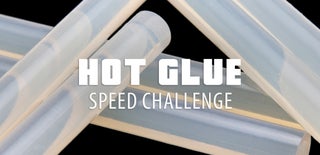Introduction: Dainty Desk Clock From Hot Glue
Everyone loves a little clock to put on their desk at home or at work. A homemade clock is especially unique. This little clock is simple, creative, and can be made from materials lying around the house!
Step 1: Gather Tools and Supplies
- Colored Hot Glue Sticks
- Scraper or Chopper
- Cutting Board
- Iron
- Parchment Paper
- Clock Repair Kit
- Ruler or Straight Edge
- Razor Blade
- Electric Drill
- Lighter
- Pencil
- Battery for Clock Repair Kit
Step 2: Cut, Cut, Cut
The first step takes the longest. All of the hot glue sticks must be cut into relatively even circles. My circles were cut to about 1/2 centimeter in thickness. The thickness is really up to you, but I found this thickness worked the best.
NOTE: If the thickness of some of the pieces are uneven, do not fret. In the end, they will all be ironed flat and even.
Step 3: Arrange and Rearrange
Next is the fun part! Place a piece of parchment paper on the ironing board and begin arranging your clock face. Designing your creation really makes it personal. Come up with whatever design you want, just make sure it is big enough to cover the clock mechanism on the back.
For my design, I started with one blue circle in the center. I then put six blue circles around that one. I did one more round of the blue before I added the pink and purple.
Step 4: Heat, Cool, Repeat
Carefully place another piece of parchment paper over the project. Be gentle so none of the pieces move around. Iron the clock face on medium heat for about 5 minutes or until the hot glue has melted to itself.
Place the project in the coldest spot in the freezer. Let it cool down until it is cold to the touch. The parchment paper will not peel off unless the project is cold.
Remove the project from the freezer and flip it over. Iron the other side for 3 minutes or until the hot glue has melted to itself. Again, place the ironed project in the freezer until it is cold to the touch.
Carefully peel all of the parchment paper off of the project. If the parchment paper starts to rip, place the project back in the freezer to let it cool down more.
Step 5: Shave the Edges
The edges are rough and the shape is not defined. There is an easy way to fix this problem. Use the ruler or straight edge to draw lines going across each side on the shape. Be sure not to cut off too much, because the hands of the watch might go beyond the clock face. Place the clock face on the cutting board and carefully cut the material with a razor blade. BE VERY CAREFUL not to cut yourself in the process! The hot glue is thick and it can be easy to slip if you are not careful.
Step 6: Drill the Hole
This step can be rather nerve wracking. Find the center of the project, and mark it well. Determine the exact thickness of the shaft of the clock mechanism and drill a hole a little bit bigger than that at the center of the clock face.
If you do not have a drill or do not want to drill into your project, you can always leave the center circle out of your design before you iron. Be careful not to iron the project so much that it makes the hole too small. This could result in the shaft of the clock mechanism not fitting into the hole.
Step 7: Begin the Assembly
As soon as the hole is drilled, put the clock mechanism through the hole and tighten all of the washers. Be sure to take note of which side you want to be the top of the clock and which side you want to be the bottom.
Step 8: Creating the Feet
An important feature about a desk-top-clock is making a way for it to stand on the desk. Sticking with the hot glue theme, cut one of the hot glue sticks in half. Find half way down both of the sticks and cut a small notch, big enough for the clock face to sit in, into the sticks. Use the lighter and slowly melt one of the notches. Place the stick with the melted glue on the far left of the bottom side. Heat up the other notch and place it on the far right of the bottom side. The clock can now stand on its own!
Step 9: Adding Hands
Put together the clock by adding the hour, minute, and second hand. Set the clock to the right time. Put the battery in the back of the clock mechanism. Your dainty desk-clock is finished!

Participated in the
Hot Glue Speed Challenge











